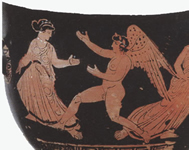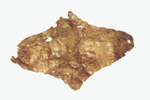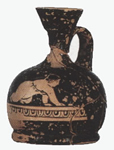Excavations of cemeteries to the west of the Strymon river have brought to light rich finds which indicate close links, most probably commercial in nature, to cities in Southern Greece from the end of the 6th Century. Attic red-figure vessels from the 4th Century are common. Among the exhibits that stand out are: a clay oenochoe in the form of a woman's head (fig. 12); a small calyx krater from Vergi with a depiction of Erotas chasing women (fig. 15); the krater with the representation of Dionysus and his attendants (fig.13) found in Kalokastro; and the hydria decorated with Dionysiac theme from Zervochori (fig. 11).
Attic red-figure hydria from Zervochori (end of the 5th Century).
Attic red-figure krater from Kalokastro. 4th Century BC.
Attic oenochoe from the early Classical period, and a detail of a red-figure krater from Vergi (4th Century).
Gold mouth-piece from a grave in ancient Gazoros. End of 6th century BC.
Busts of female deity. End of the 6th, beginning of the 5th century BC. Ancient Tragilos. The ancient city in the Terpni area was founded at the end of the Archaic Period, but was at its apex during Roman times when a Roman basilica was built in its centre. The sculptures from the city's public buildings are indeed impressive.
The extensive excavations of ancient Tragilos and the city's cemeteries have brought to light significant finds which bear witness to the city's fortunes from the end of the 6th Century until the beginning of the 3rd Century BC when it was destroyed by invaders and abandoned. A grate number of clay figurines and offerings (fig. 16, 17, 18) were unearthed in a temple dedicated to a female deity, and everyday objects have been found in private dwellings. Outstanding among the grave goods and the Attic vases is a red-figure pelike by "Pronomos the artist" with its depiction of the fight between giants and gods (fig. 19). Locally-produced copper jewellery is often found in archaic tombs, as well as gold stoppers and weapons.
Bust of a female deity. 4th Century. Ancient Tragilos.
A figurine of Lyda with Swan. End of the 4th Century. Ancient Tragilos.
Argilos, a colony of Andros in the 7th Century BC, has provided the Serres Museum with a funerary bed (fig. 21), marble door from a Macedonian tomb, and artefacts from its 5th Century cemetery, including vessels, figurines, copper strigils and iron weapons, all of which are valuable items buried with adults and children. A large number of clay vessels were produced in workshops in Attika and transported to the Strymon estuary by sea. (fig. 20,23)
Lekythos with red-figure depiction of a child. Ancient Argilos.
The exceptionally well-crafted marble statues of Gods from the Hellenistic Era which were unearthed in the area of the ancient city of R.S. of Aggista illustrate the importance of the city which, in ancient times, was situated on the main route between Philippi and Siris and Irakleia Sintiki.
Inscriptions and decrees have been found in ancient Gazoros, well-known for the worship of Gazorian Artemis during the Roman period. These finds provide us with valuable information on the city's history and organisation during the Hellenistic and Roman periods (fig. 26). Archaic, Classical and Hellenistic graves have been discovered containing rich offerings: weapons, coins, clay vessels and jewellery.
An honorary decree from the Hellenistic Period. Ancient Gazoros.
Decree from the ancient city of Neos Skopos. The ancient city in the area of Neos Skopos, which seems to have been in its prime from the end of the archaic era right through the Classical and Hellenistic periods has yielded rare artefacts: examples of pottery of a very high standard of workmanship (fig. 25), inscriptions (fig. 27), and ceramics both imported and locally produced.
Sidirokastro, identified by some scholars with Irakleia Sintiki, has hardly been excavated at all. However, the superb collection of funerary stelae from the city's Roman cemetery (fig. 29), and several inscriptions, indicate the existence of a city of some importance in ancient times.
Today, the Serres Archaeological Museum is inundated with a geometrically increasing number of artefacts. The finds from ancient Amphipolis and its surrounding area (ancient Argilos and Iiona) have been gathered together and are exhibited in the local museum, while all other finds from the prefecture are to be found in Serres. Although many of these have come to the museum as chance finds, the rest are the outcome of excavations during the last three decades.
Writer:
Magdalene Valla














